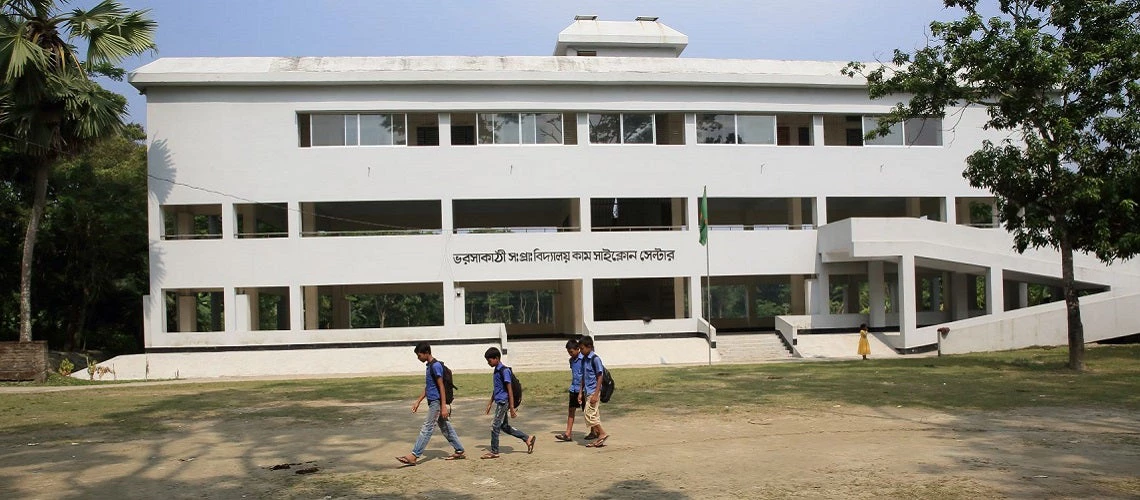 Uttar Seral Government Primary School, which is also a cyclone shelter, in Barishal, Bangladesh.
Uttar Seral Government Primary School, which is also a cyclone shelter, in Barishal, Bangladesh.
Many people know that the World Bank Group is the largest financier of education in the developing world, having committed nearly $20 billion between 2016 and 2020 and supervising operations in over 80 countries. Many people also know that the Bank is the largest multilateral funder of climate action across different sectors in developing countries, topping $83 billion between 2016 and 2020.
Many people do not know, however, about the layered and multifaceted connections between the Bank’s work in education and climate action. Much has been written about how we can deploy the power of education to better combat climate change, and those recommendations need to be emphasized regularly, but it’s also important to recognize how steps taken today are helping to address climate change and its impact on education systems, and vice versa.
1) Providing more and better education and research on climate change and its impact
Perhaps the best and most obvious example comes from the Africa Higher Education Centers of Excellence (ACE) program. The World Bank, in a series of projects (ACE I, ACE II and the First and Second ACE Impact), in support of 20 sub-Saharan African governments, has provided more than $580M through International Development Association (IDA), to 77 centers in 55 universities. More than 24,000 students have enrolled in postgraduate (and select bachelors) degree programs. The program is designed to increase the quality and provision of applied research and higher education with a focus on the areas of agriculture, health, science, technology, engineering and mathematics (STEM), including computer sciences, water and electrical engineering, transport and logistics, environmental sciences – all of which offer important insights into climate-related issues. For example, the ACE in Coastal Resilience (ACECoR) in Ghana, is building technical and scientific capacity to develop integrated solutions to address coastal degradation. Other exciting work is underway at research centers such as: the CEA en Environnement, Santé et Sociétés (CEA-AGIR) in Senegal; the CEA en Changement Climatique, Biodiversité et Agriculture Durable (CCBAD) in Côte d'Ivoire; the Water Infrastructure & Sustainable Energy Centre for the Futures (WISE FUTURES) in Tanzania or the ACE for Climate Smart Agriculture and Biodiversity Conservation (Climate SABC) in Ethiopia. These centers offer programs and research in renewable and sustainable energy, air quality, restoration of degraded environments, climate and biodiversity related fields, including dryland resources management and smart/sustainable agriculture.
"The Africa Higher Education Centers of Excellence program is designed to increase the quality and provision of applied research and higher education with a focus on the areas of agriculture, health, science, technology, engineering and mathematics (STEM), including computer sciences, water and electrical engineering, transport and logistics, environmental sciences – all of which offer important insights into climate-related issues."
2) Building climate-resilient education infrastructure and systems
In Bangladesh, for instance, with the support of the World Bank’s Multipurpose Disaster Shelters Project, primary schools are being constructed or retrofitted to serve as cyclone shelters, greatly reducing casualties from cyclones. The project is helping to make the coastal population in Bangladesh less vulnerable to natural disasters through 552 new shelters, 450 rehabilitated shelters, and about 550 kilometers of new rural roads to serve the communities and improve access to shelters. The project is also supporting community-based early warning initiatives and fitting shelters with solar panels and rainwater-harvesting devices. The shelters will provide universal access to better accommodate the needs of people with disabilities and the elderly and include separate rooms for nursing mothers.
While many examples exist of Bank-financed projects making schools and other education infrastructure better equipped to withstand climate-related shocks or ensuring new buildings and equipment are more environmentally friendly, the Bank is also working to emphasis system-level resilience. In Turkey, for instance, the World Bank recently approved a $160M loan to enhance the capacity of Turkey’s education system to provide e-learning equitably to school-age children during the COVID-19 pandemic and future shocks. Turkey is particularly vulnerable to the impacts of climate change, including rising temperatures which increase the frequency and impact of climate‐related hazards, such as a catastrophic flood in 2019. While the Bank-financed project is meant to strengthen the education system’s response to COVID‐19, improving the reach and resilience of Turkey’s e-learning will also improve the system’s ability to confront disruptive, climate-related shocks in the future. By the end of the project, the e-learning capacity will be able to accommodate more than 5 million students concurrently through more than 100,000 virtual classrooms. For good measure, the project is also exploring how to ensure the e-learning platform can be designed and implemented in ways that reduce its carbon emissions – a second significant potential win for climate!
"In Bangladesh, with the support of the World Bank’s Multipurpose Disaster Shelters Project, primary schools are being constructed or retrofitted to serve as cyclone shelters, greatly reducing casualties from cyclones."
3) Strengthening community resilience to climate’s impact on education
Up until the 2019 school year, the Democratic Republic of Congo was one of only a few countries where primary schools still charged fees. Households, on average, had to spend nearly $65 per year per child for primary school: a steep price for poor families. Through IDA, the Bank is providing $800M for the Emergency Equity and System Strengthening in Education Project to reduce school expenses for the poorest households, increase children’s access to primary education in 10 provinces, and strengthen the education system across the country. Already an additional 2.5 million children from disadvantaged backgrounds have been able to attend school.
What does this have to do with climate change? While not immediately apparent, the connection is vital: by eliminating public primary school fees, poor households will not have to choose between food and education for their children when faced with climate-related shocks like droughts or floods. Families and communities should be able to bounce back faster and with fewer long-term impacts on their human capital and well-being when facing climate-related shocks.
These examples are meant to illustrate the different connections between education and climate change. Around the world, young voices are increasingly driving the climate conversation – these examples and results, and there are many more, are a reminder that investing smartly in education can also bring about a climate-smart, resilient future.
"Around the world, young voices are increasingly driving the climate conversation – these examples and results, and there are many more, are a reminder that investing smartly in education can also bring about a climate-smart, resilient future."


Join the Conversation